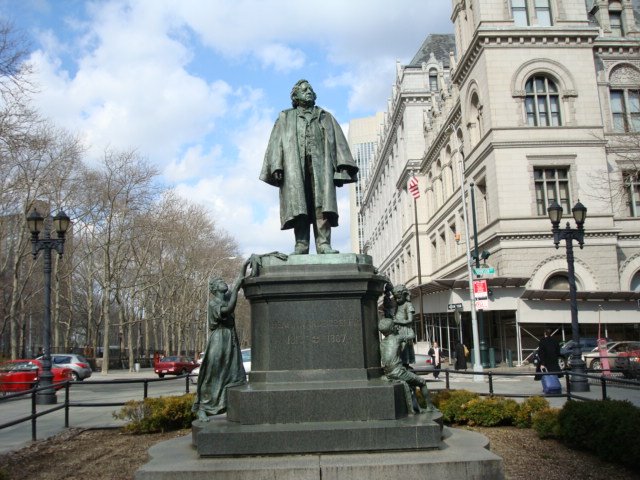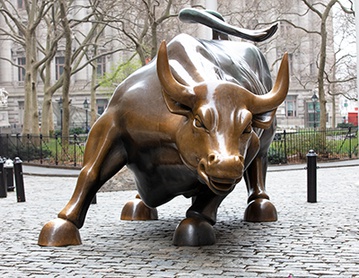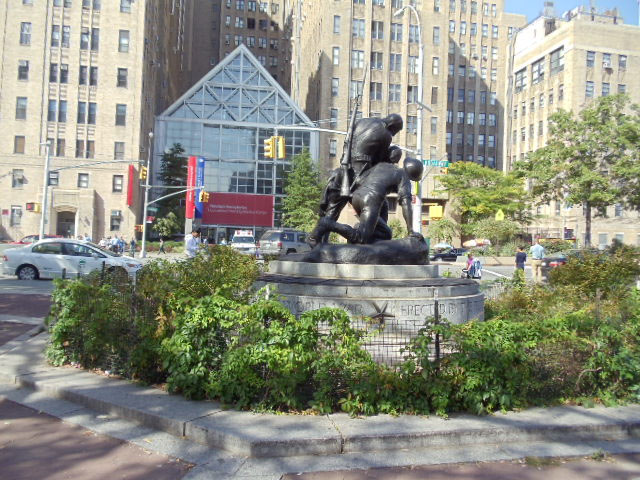
While I was walking to my school I found Christopher Columbus statue. The monument at this one in front of the Kings County Supreme Court , created by Italian sculptor Gaetano Russo, was erected as part of New York’s 1892, the sculpture was a gift to the city in 1892, paid for by public subscription. The funds were collected in 1892, but the sculpture was not installed until two years later. It is a copy of a work located in Madrid. The monument consists of a marble statue of Columbus atop a 70-foot (21 m) granite rostral column decorated with bronze reliefs representing Columbus’ ships.
This sculpture has been described as representing the navigator “standing upon the deck of a ship alone…before the West Continent burst into view,” ship’s tiller in hand, as his “mutinous crew have all deserted him.” Emma Stubbiness (1815–1882) carved this colossal marble sculpture in the late 1860s. She was one of several female expatriate artists living in Rome at the time whom author Henry James dubbed “the white marmorean flock.” The sister of Park Board President Henry Stubbiness, she is best known for creating the bronze statue of the Angel of the Waters at the center of Central Park’s Bethesda Fountain.

 While I walking to my school I saw this statue of Beecher sits in Columbus Park in front of Brooklyn Borough Hall. Beecher was born on June 13, 1813 in Litchfield, Connecticut, and was the son of a well-known Presbyterian minister, Lyman Beecher (1775–1863). Among Henry Ward’s ten siblings was his sister Harriet Beecher Stowe (1811–1896), author of the classic anti-slavery novel, Uncle Tom’s Cabin first published as a serial in 1851–52. The figure was designed by John Quincy Adams Ward he is the best known for his George Washington in front of Federal Hall and dedicated in 1891, just four years after Beecher’s death.
While I walking to my school I saw this statue of Beecher sits in Columbus Park in front of Brooklyn Borough Hall. Beecher was born on June 13, 1813 in Litchfield, Connecticut, and was the son of a well-known Presbyterian minister, Lyman Beecher (1775–1863). Among Henry Ward’s ten siblings was his sister Harriet Beecher Stowe (1811–1896), author of the classic anti-slavery novel, Uncle Tom’s Cabin first published as a serial in 1851–52. The figure was designed by John Quincy Adams Ward he is the best known for his George Washington in front of Federal Hall and dedicated in 1891, just four years after Beecher’s death.
 While we went to a trip to the Metropolitan museum of art this May 6, 2017, some of the statue that I found interesting was the first statue when we entry to the museum. This status is the Marble statue of Athena Parthenos, Greek Hellenistic period, c,a 170 after the mid 5th century , chryselephantine cult statue of Athena Parthenos by Pheidias in Athens. The cult statue of Athena in the Parthenonn at Athens was still standing while the Hellenistic kingdom of Pergamon was flourishing. Moreover, the ties between the two centers were extensive.
While we went to a trip to the Metropolitan museum of art this May 6, 2017, some of the statue that I found interesting was the first statue when we entry to the museum. This status is the Marble statue of Athena Parthenos, Greek Hellenistic period, c,a 170 after the mid 5th century , chryselephantine cult statue of Athena Parthenos by Pheidias in Athens. The cult statue of Athena in the Parthenonn at Athens was still standing while the Hellenistic kingdom of Pergamon was flourishing. Moreover, the ties between the two centers were extensive.





